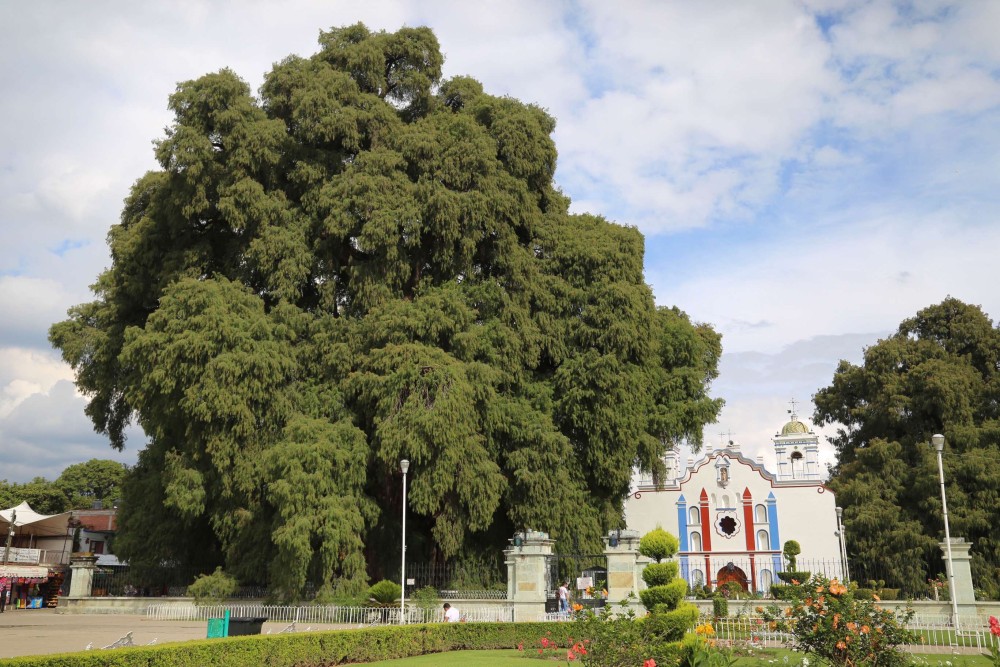
El Arbol del Tule was planted on a sacred site well over 1,000 years ago by a Zapotec priest and is now home to a Catholic church.
Scientific surveys have recently estimated as many as three trillion trees grow all over the world. But out of that mind-boggling number, only a handful of specimens are majestic enough to be considered iconic. The tree with the largest trunk girth on earth, El Arbol del Tule, grows in a church courtyard in the small village of Santa Maria del Tule in the southern Mexican state of Oaxaca.

Now protected by a fence to keep visitors off the tree’s roots, El Tule is a landmark in Oaxaca and is famous around the world.
Certainly there are taller trees, ones with a larger volumes of wood, and others thought to be older, but none has the immense girth of El Tule (too-lay), which is estimated to have a circumference of more than 160 feet and a diameter of more than 38 feet. Scientists and arborists who have studied El Tule estimate it to be between 1,200 and 1,600 years old.

The sheer size and complexity of the tree’s trunk make it a true wonder of nature.
El Tule is a Montezuma Cypress that got its foothold and thrived centuries ago thanks to the then-swampy land in that area of Oaxaca. It is believed El Tule was planted around 1,400 years ago by Pecocha, a Zapotec priest who worshipped the wind god Ehecatl. And El Tule is still considered sacred by the people in the area and many others across the globe.

The massive trunk gives way to enormous branches that create a majestic canopy of shade and tranquility.
El Tule is recognized around the world as an icon and visitors to Oaxaca, particularly repeat visitors, consider a stop to see El Tule as a sign of respect. Guinness World Records and National Geographic are among the organizations that regularly cite El Tule as the having the greatest girth in the world.

Cypress leaves are not broad like a maple or magnolia, but are an excellent mechanism for evapotranspiration.
Broad as its base is, El Tule is not particularly tall, reaching only around 120 feet into the sky. By contrast, General Sherman, a giant sequoia in California’s Sequoia National Park, has a base circumference of approximately 120 feet and tops out at nearly 275 feet tall.

Over the centuries, El Tule’s trunk has grown textured and gnarled.
For a number of years, El Tule was thought to be as many as three separate trees that grew together to form a single trunk. However, DNA testing has shown the entire base is genetically identical, making it a single tree.

Some of today’s visitors are able to get up-close photographs and videos without trampling El Tule’s roots.
El Tule is under pressure from a number of different fronts. Population growth in the area has soared, increasing the demand for water. So, a once-swampy area has all but dried up, the water table is now lower and this has reduced groundwater available to El Tule. Climate change has altered temperature and rainfall patterns, making it harder for the tree to thrive (the amount of rain and overall humidity have decreased). Researchers note the southern face of the tree is showing signs of stress. And the thousands of motor vehicles that rumble by the area, along with increased air pollution, also threaten El Tule.

El Tule is sometimes called a “Tree of Life” because some of the features on the trunk resemble wild creatures.
El Tule has been here for more than a millennium. Just how much longer this sacred arboreal giant will survive is a challenge El Tule and billions of other trees around the world face.

Sunlight peeks through the leaf canopy of El Tule on an autumn afternoon as branches spill beyond the protective fence.
These are vital considerations given that trees are oxygen generators and therefore the lungs of our world. Without photosynthesis, the carbon dioxide humans exhale with each breath would not be converted back to oxygen that people and animals need to survive.

El Tule is one of nature’s most amazing trees and a visit to see it is one that will always be remembered.
It’s a thought worth considering the next time you take a breath.

One can spend hours studying and appreciating the massive trunk of El Tule.
For more information:
wikipedia.org/wiki/List_of_superlative_trees
greenliving.about.com/Largest-Tree-Oldest-Tree-in-the-World
nationalgeographic.com/photos/sacred-and-iconic-tree
guinnessworldrecords.com/living-tree-with-greatest-girth
npr.org/tree-counter-is-astonished-by-how-many-trees-there-are
acityamonth.com/sequoia-and-kings-canyon-biggest-trees-in-the-world
